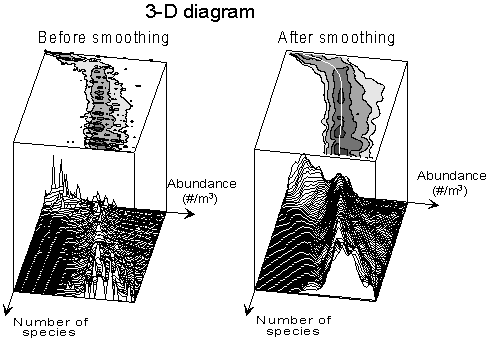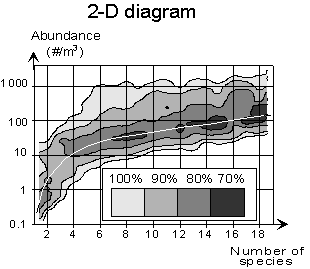


formerly the National Oceanographic Data Center (NODC)... more on NCEI


 |
|
formerly the National Oceanographic Data Center (NODC)... more on NCEI |
|
NCEI is transitioning to a new website and paths to data resources will be changing. Please contact NCEI.Info@noaa.gov with any questions of issues. See the new website at www.ncei.noaa.gov.
| You are here: NODC Home > Ocean Climate Laboratory > OCL Products > BAAS2000 > Main menu > Documentation contents: Ch. 5 |
5. QUALITY CONTROL OF HYDROBIOLOGICAL DATA
5.1. Physical and hydrochemical data
Quality control of physical, hydrochemical, and meteorological data was conducted using the method described by Conkright, et al. (1998), Matishov et al., 1998.
In order to process data for the period 1952-1959 it was necessary to combine the biological and physical data. The primary information was presented in the form of two arrays each with a different data structure. The first array consisted of physical data grouped by cruises. The name of the research vessel and geographic coordinates for each station were present for each cruise. The second array consisted of weight characteristics for the phytoplankton samples. The number of the station and sample location was specified for each sample. Both arrays were then merged, based on table defining relationships between the station numbers and coordinates of stations.
One of the necessary quality control stages in processing hydrobiological data consists of checking a parameter value against permissible ranges. Reference materials are available presenting the range of measurements of oceanographic characteristics for different Barents Sea regions (Matishov et al., 1998). We are not aware of papers presenting the information on permissible range of plankton data for different regions of the Barents Sea. The present section considers some generalities of the plankton population, based on which criteria for hydrobiological data control were generated.
Phytoplankton
The papers of Druzhkov and Makarevich (1991), Druzhkov et al. (1997), Roukhiyainen (1967), Ryzhov (1985), Druzhkov and Makarevich (1999) discuss the generalized scheme for phytoplankton community functioning (succession scheme) in the southern the Barents Sea. The structure of succession systems of the other Barents Sea regions, in general, is similar to the structure considered in the following section. The difference consists in timing of the phytoplankton bloom and its duration.
Spring. Middle of March-Beginning of June
In the spring, phytoplankton activity is characterized by the appearance of early spring diatoms in the coastal pelagic zone in the second half of May. Thalassiosira hyalina (Grun.) Gran, T. cf.gravida Cl., Navicula pelagica Cl., N. septentrionalis (Grun.) Gran, Nitzschia grunowii Hasle, Amphora hyperborea (Grun.) are the main constituents in the composition of the early spring diatoms complex that replicates each year. At this time, cell numbers are low and can vary, depending on species composition, from tens to several hundred cells per liter. The biomass of phytoplankton reaches a maximum in the second part of April. The peak of biomass itself is a short-term phenomenon, and the biomass maximum is present only for several days. During the early blooming season, phytoplankton abundance can vary between several hundred thousands to 2 million cells/liter (from unpublished data of M. Roukhiyainen it can vary up to 12 million cells/liter), and biomass can vary between 1 and 3 mg/liter. During this period, the concentration of greatest biomass is observed within the 0-10m layer. Thalassiosira cf.gravida Cl., T. nordenskioeldii Cl., Chaetoceros socialis Laud., C. furcellatus Bail., Navicula vanhoeffenii Gran. are species forming the first peak of the Barents Sea phytoplankton bloom. During some years, this period is characterized by an intensive development of Phaeocystis pouchetii (Hariot) Lagerh., which can attain great values in its abundance and biomass, and participate actively in the formation of the spring maximum (the documented peak abundance and biomass were 8 million cells/liter and 1.7 mg/liter, respectively; Druzhkov and Makarevich, 1989).
Summer. End of June-End of August
The significant changes in the phytoplankton community occured during the summer season. The number of diatoms sharply decrease. At the same time a sporadic increase of dinoflagellates is observed though their presence in the pelagic zone. Pronounced replacement of the Arctic boreal forms by cosmopolitan ones, and neritic forms by panthalassic and oceanic ones, are observed. During this season, the dominant group is basically comprised of the diatoms Skeletonema costatum (Grev.) Cl., Leptocylindrus danicus Cl., L. minimus Gran, Chaetoceros decipiens Cl., C. laciniosus Schutt, and dinoflagellate algae of the genus Protoperidinium. The maximum abundance of the pelagic algae cells does not exceed 20,000 per liter.
Fall. Middle of September-End of November
The maximum microalgae cell concentration is in the 0-25 m depth layer. The dominant components of the microalgae community are: diatoms of the genus Chaetoceros and dinoflagellates of the genus Ceratium, Dinophysis, Protoperidinium. During this period, cell abundance usually does not exceed 2,000 per liter. By early December, the abundance of cells is less than 1,000 per liter, and biomass is less than 5 µkg/liter. In the pelagic zone dinoflagellates are dominant, and nanoplanktonic flagellates remain as the only active group of phytosynthesyzing organisms.
Winter. Beginning of November-End of March
Throughout the entire winter, the phytoplanktonic community is in a resting stage, i.e. its vital functions are almost inactive. In the pelagic zone, phytoplankton are represented by large oceanic dinoflagellates of cosmopolitan and Arctic boreal origin. The dominant component consist of Ceratium longipes (Bail.) Gran, C. tripos (O.Müll.) Nizsch, Dinophysis norvegica Clap. Et. Lachm., Protoperidinium depressum (Bail.,) Balech.
The table below presents quantitative characteristics of the annual development cycle of Barents Sea phytoplankton. This table determines the range of permissible values for the dominant phytoplankton species for the southern Barents Sea.
Barents Sea: quantitative characteristics of the phytoplankton annual cycle
Region: 74oN - Kola Peninsula
PG - phytogeographic characteristics (A = arctoboreal species; B = boreal species; C = cosmopolitan species);
EG - ecological characteristics (O = oceanic forms; N = neritic forms; P = panthalassic forms; M = microphytobenthos; F = freshwater forms).
| Time | Depth of the habitat (m) | Ecological structure | Dominant taxa | Total count
(cells/liter) |
| Spring | ||||
| Middle of March - Beginning of June | 0-70 | N > O+P+M+F
A > B+C |
Phaeocystis pouchetii
Thalassiosira gravida T. nordenskioeldii Navicula Nitzschia grunowii Chaetoceros socialis |
100,000 - 12,000,000 |
| Summer | ||||
| End of June -
End of August |
0-50 | C ³ A+B
N ³ P+O |
Leptocylindrus danicus
L. minimus Chaetoceros decipiens C. laciniosus Protoperidinium Skeletonema costatum |
|
| Fall | ||||
| Middle of September -
End of November |
0-25 | C > A; C > B
O ³ P; O ³ N |
Chaetoceros
Ceratium Dinophysis Protoperidinium |
> 2,000 |
| Winter | ||||
| Beginning of November -
End of March |
0-bottom | O > N
O > P; C+A > B |
Ceratium
Protoperidinium |
10 - 500 |
Zooplankton
Determining a permissible range of variation is an important element of the quality control of hydrobiological data. The availability of 9,000 zooplankton samples in the database makes it possible to consider the relationship between abundance and number of species.
The figure below presents a graph illustrating the relationship between
zooplankton number of species per m3 and their abundances per m3
for the Barents Sea and the Kara Sea (holoplankton only). The observed relationship
is in good agreement with the theoretical curves widely used in ecology
(Magurran, 1988).
 |
 |
The graph given in the figure can be tabulated for simplification of
the algorithmic procedure for data quality control.
| Number of species (#/m3) | 1 | 2-3 | 4-5 | 6-10 | 11-15 | 16-20 | >20 |
| Minimum abundance (#/m3) | 0.1 | 1 | 3 | 10 | 12 | 14 | >15 |
| Average abundance (#/m3) | 1-75 | 76-200 | 201-260 | 261-350 | 351-400 | 401-450 | >450 |
| Maximum abundance (#/m3) | 150 | 350 | 1500 | 2500 | 2550 | 2600 | >2600 |
| Last modified: Fri, 5-Oct-2007 17:30 UTC | NCEI.info@noaa.gov | ||
|
Freedom of Information Act (FOIA)
USA.gov - The U.S. Government's Web Portal
|
|||